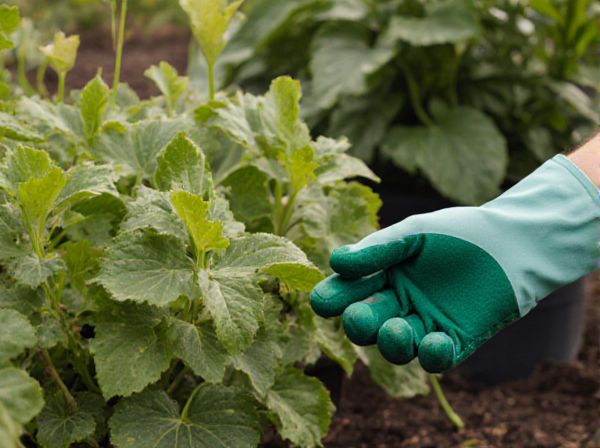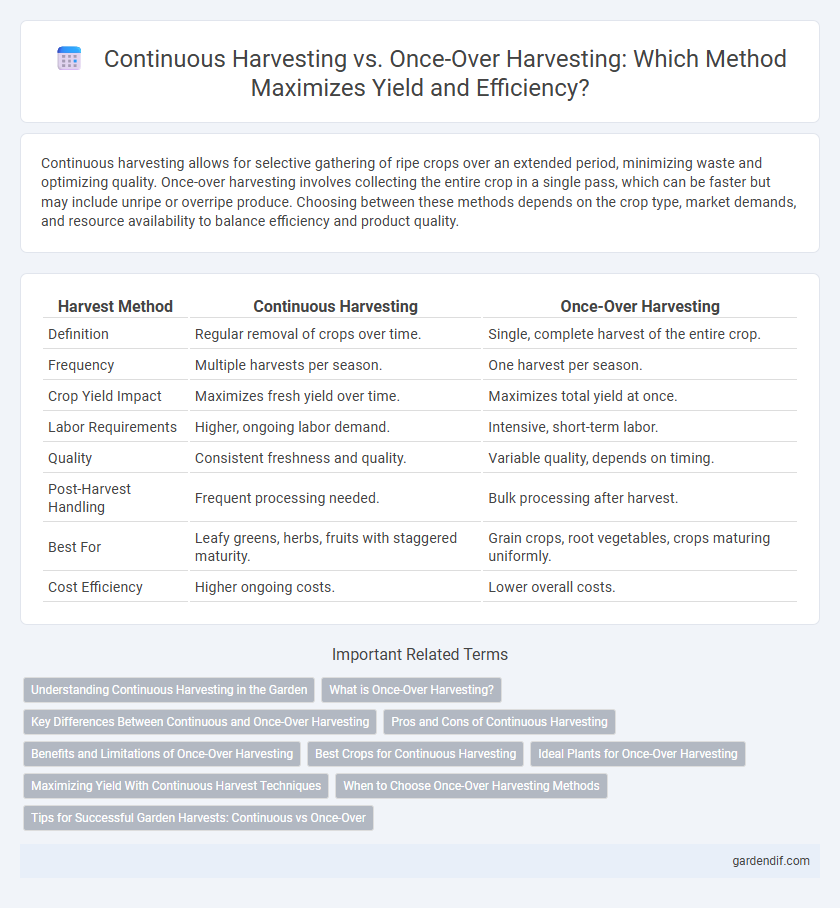
Continuous Harvesting vs Once-Over Harvesting Illustration
Continuous harvesting allows for selective gathering of ripe crops over an extended period, minimizing waste and optimizing quality. Once-over harvesting involves collecting the entire crop in a single pass, which can be faster but may include unripe or overripe produce. Choosing between these methods depends on the crop type, market demands, and resource availability to balance efficiency and product quality.
Table of Comparison
| Harvest Method | Continuous Harvesting | Once-Over Harvesting |
|---|---|---|
| Definition | Regular removal of crops over time. | Single, complete harvest of the entire crop. |
| Frequency | Multiple harvests per season. | One harvest per season. |
| Crop Yield Impact | Maximizes fresh yield over time. | Maximizes total yield at once. |
| Labor Requirements | Higher, ongoing labor demand. | Intensive, short-term labor. |
| Quality | Consistent freshness and quality. | Variable quality, depends on timing. |
| Post-Harvest Handling | Frequent processing needed. | Bulk processing after harvest. |
| Best For | Leafy greens, herbs, fruits with staggered maturity. | Grain crops, root vegetables, crops maturing uniformly. |
| Cost Efficiency | Higher ongoing costs. | Lower overall costs. |
Understanding Continuous Harvesting in the Garden
Continuous harvesting in the garden allows for regular picking of fruits, vegetables, and herbs as they ripen, which maximizes yield and ensures fresh produce throughout the growing season. This method promotes healthier plants by reducing stress and damage caused by removing all produce at once and supports sustainable gardening practices by maintaining soil quality and plant vigor. Gardeners practicing continuous harvesting often see improved crop productivity and extended harvest periods compared to once-over harvesting.
What is Once-Over Harvesting?
Once-over harvesting is an agricultural method where the entire crop is harvested in a single pass, maximizing efficiency and minimizing labor costs during a specific harvest window. This technique is commonly used for crops like grains and root vegetables, where uniform maturity allows for one-time collection. While it reduces operational complexity, once-over harvesting may lead to yield losses if the crop matures unevenly or if weather conditions change abruptly during the harvest period.
Key Differences Between Continuous and Once-Over Harvesting
Continuous harvesting involves regularly collecting crops or resources in smaller increments throughout the growing season, ensuring steady yield and minimizing waste. Once-over harvesting, by contrast, gathers the entire crop at a single point in time, maximizing efficiency but potentially increasing risk of loss due to weather or spoilage. Key differences include harvest timing, labor distribution, and impact on crop quality, with continuous harvesting promoting sustained productivity and once-over harvesting favoring operational simplicity.
Pros and Cons of Continuous Harvesting
Continuous harvesting enhances productivity by allowing selective crop removal over time, reducing waste and optimizing resource use. It supports constant market supply and minimizes soil disturbance, promoting sustainable soil health. However, continuous harvesting demands higher labor and management costs, and may increase pest and disease risks due to prolonged crop exposure.
Benefits and Limitations of Once-Over Harvesting
Once-over harvesting allows for a single, large-scale crop collection, reducing labor costs and minimizing equipment use. This method can lead to uniform product quality and easier scheduling but may cause increased risks of crop loss due to weather or pest outbreaks. The inflexibility in timing can also result in uneven crop maturity and decreased overall yield efficiency compared to continuous harvesting systems.
Best Crops for Continuous Harvesting
Continuous harvesting is ideal for crops like lettuce, spinach, kale, and herbs, which allow for multiple pickings over the growing season, maximizing yield and freshness. These crops regenerate quickly, enabling growers to gather produce without replanting, reducing labor and increasing market presence. Selecting high-yield, fast-growing vegetables enhances efficiency and supports sustainable harvesting practices.
Ideal Plants for Once-Over Harvesting
Ideal plants for once-over harvesting are those that mature uniformly and have a short harvest window, such as wheat, corn, and potatoes. These crops benefit from a single, large-scale harvest that maximizes efficiency and reduces labor costs. Uniform growth allows for streamlined machinery use, minimizing crop damage and preserving quality during collection.
Maximizing Yield With Continuous Harvest Techniques
Continuous harvesting techniques enhance crop yield by enabling multiple, staggered harvests throughout the growing season, reducing waste and increasing overall productivity. Unlike once-over harvesting, which collects all produce at a single time, continuous harvesting allows for optimal ripeness and quality by targeting crops as they mature. Implementing continuous harvest methods aligns with sustainable agricultural practices and maximizes resource efficiency, leading to higher economic returns for farmers.
When to Choose Once-Over Harvesting Methods
Once-over harvesting methods are ideal for crops with uniform maturation, such as wheat and soybeans, optimizing efficiency by collecting the entire yield in a single pass. This method reduces labor costs and machinery use but requires precise timing to prevent quality loss or wastage. Selecting once-over harvesting is most beneficial when market demand favors bulk delivery and storage conditions support immediate processing.
Tips for Successful Garden Harvests: Continuous vs Once-Over
Continuous harvesting maximizes crop yield by regularly picking mature vegetables like beans and tomatoes, encouraging plants to produce more over time. Once-over harvesting suits root crops such as carrots and potatoes, where all produce is collected at once to prevent spoilage and simplify processing. Selecting the method based on plant type and garden goals ensures a steady supply of fresh produce or a single efficient harvest, optimizing both time and resources.
Continuous Harvesting vs Once-Over Harvesting Infographic

 gardendif.com
gardendif.com